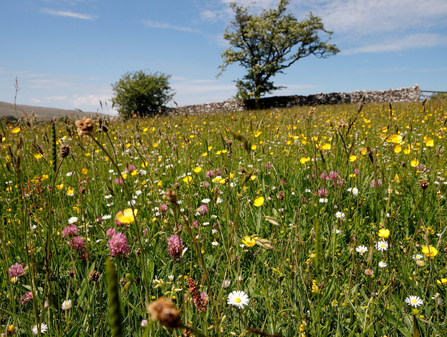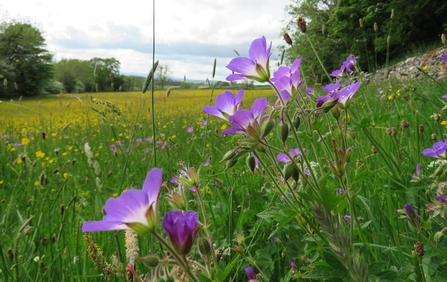
Funding will help us restore and re-connect important species-rich grasslands in Cumbria © Cumbria Wildlife Trust

Funding will help us restore and re-connect important species-rich grasslands in Cumbria © Cumbria Wildlife Trust
We have joined forces with National Highways to launch a new Network for Nature project, with 16 grassland sites across Cumbria benefitting people, nature and wildlife.
From limestone grassland in Arnside, one of the sunniest and driest places in Cumbria, to a site not far from the wettest place in Cumbria, 16 areas of grassland will be transformed into species-rich meadows and flowery pasture, to support a wide range of plants and pollinating insects. They include lakeside settings near Coniston and Ullswater and upland hay meadows in the Westmorland Dales.
We'll work with landowners and tenants to create, restore and connect 71 acres of grassland. Around 15,000 plug plants will be planted, to increase the range of flowering plants, give pollinators more opportunities to forage, and join up important habitats that are currently fragmented. The sites range from small farms and orchards of just under an acre, to larger areas of land within the Arnside and Silverdale AONB or owned by the National Trust.
Claire Cornish, Grassland Officer for Cumbria Wildlife Trust said: “We are very grateful to National Highways for this brilliant funding. We live in one of the most nature depleted countries in the world. We’ve lost of 97% of lowland meadows which once hummed with the buzz of bees, and beautiful butterflies. So we must act now to save what’s left!
“There’s an amazing variety of wild pollinators in Cumbria, including bumblebees, hoverflies, solitary bees, butterflies and moths. They depend on flower-rich habitat to survive. The loss of this precious habitat, mainly through changes in farming practices, has led to their decline.
“Our vision for the future of these hay meadows is that by working with landowners, we can change management practices over the long term, join up fragmented places that can support a wealth of wildlife and provide amazing places for people to enjoy.”
The sites for restoration include a farm near Newbiggin in the Westmorland Dales. This area has some of the best examples of northern hay meadow but even here, a hotspot for traditional hill farming and hay making, flower-rich meadows are still being lost when tenancies or farming practices change.
We'll help this landowner to restore almost his entire holding of three fields into flower-rich meadows. These fields are next to other healthy meadows at a neighbouring farm and the open fell, which is used by wading birds. Enhancing the grassland and bringing back traditional management will re-connect these fragmented landscapes and allow species to move more freely within them.

Flower-rich grasslands at Bowber Head Farm ©Cumbria Wildlife Trust
Chloe O’Hare, National Highways Environment Team Manager for the North West, said: “We are pleased to be working in partnership with Cumbria Wildlife Trust to support and enhance biodiversity. It’s a great example of the work the Wildlife Trust is doing to safeguard a wide variety of species – both insect and plant – which play a vital role in pollination. This demonstrates the value and potential of our Environment and Wellbeing Designated Funds Programme, which ringfences funding for vital work such as this. We are proud to be supporting this transformation of grassland in Cumbria, and look forward to seeing the results in the future.”
Nikki Robinson, Network for Nature Programme Manager for The Wildlife Trusts said: “Creating and restoring traditional hay meadows for wildflowers will give nature in Cumbria a welcome boost for biodiversity. We’re very pleased that National Highways is committed to Network for Nature, with a strategic approach to restoring nature and joining up vital places for wildlife, to help counter the impacts of previous road building.
“Historic road building programmes have contributed to nature’s decline, fragmenting wild spaces and causing environmental pollution, and this programme will help Wildlife Trusts throughout England carry out important nature conservation work. It will contribute to a national Nature Recovery Network, connecting town and countryside, joining up vital places for wildlife, and promoting landscape-scale connectivity.”
There will be opportunities for volunteers to help with surveying and plug-planting at some of the 16 sites across Cumbria. Keep an eye on our website.
In Cumbria only 15% of land is currently protected for wildlife and only one fifth of this protected land is in a good condition for wildlife. The Wildlife Trusts are calling for at least 30% of our land and sea to be connected and protected for nature’s recovery by 2030.
Network for Nature is an £8million programme managed by the Royal Society for Wildlife Trusts and funded through National Highways’ Environment and Wellbeing Designated Funds programme.
Over the next four years, 20 Wildlife Trusts in England are working on a huge range of projects from chalk downlands to boost rare butterflies, to creating and restoring wetlands, and conserving rare chalk streams for endangered water voles. Some Trusts are using natural solutions, like reedbeds and ponds to help filter polluted road run-off and stop it going into rivers or nature reserves. Overall, 39 biodiversity projects will enhance, restore and create more than 2,957 acres (1,197 hectares) of woodlands, grasslands, peatlands and wetlands across every region of England.
National Highways is the company responsible for England’s motorways and major A-roads. Currently in its third year, National Highways’ Designated Funds programme is divided into four funding streams: environment and wellbeing, users and communities, safety and congestion and innovation and modernisation.